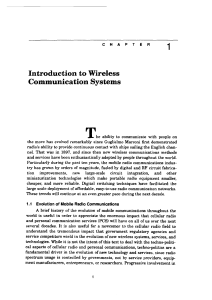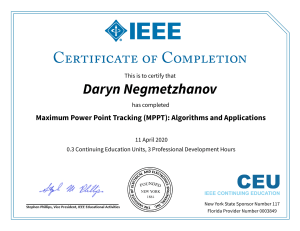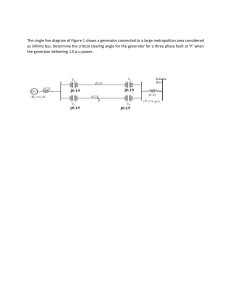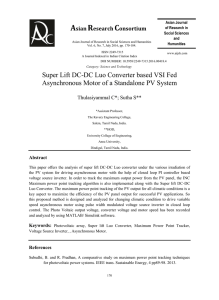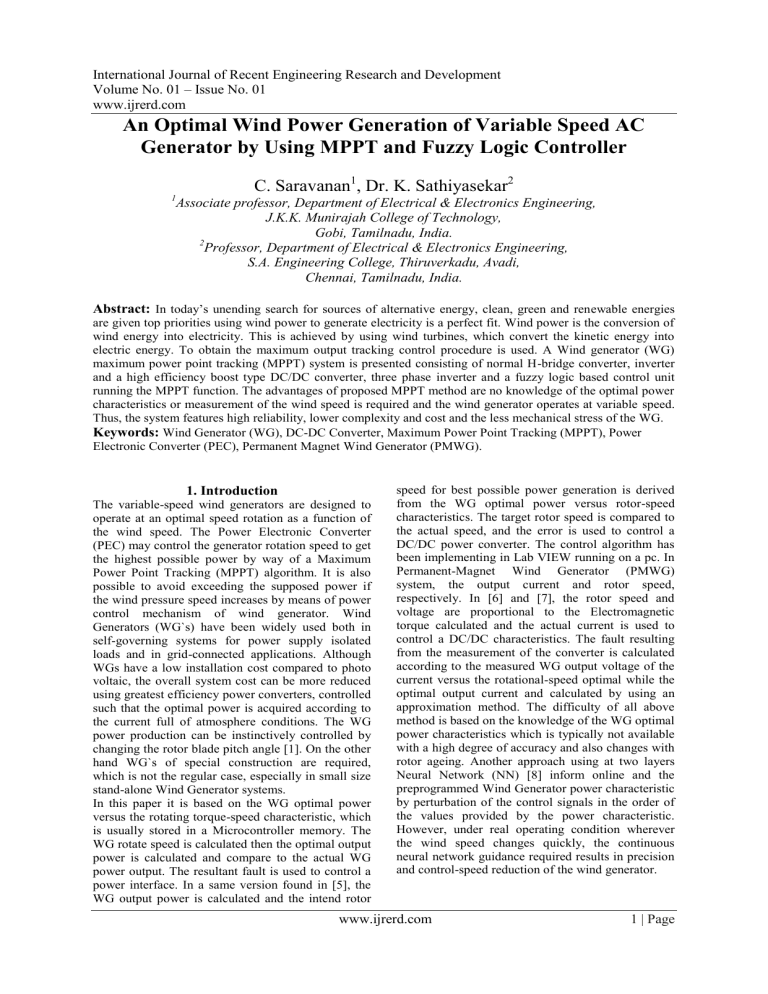
International Journal of Recent Engineering Research and Development Volume No. 01 – Issue No. 01 www.ijrerd.com An Optimal Wind Power Generation of Variable Speed AC Generator by Using MPPT and Fuzzy Logic Controller C. Saravanan1, Dr. K. Sathiyasekar2 1 Associate professor, Department of Electrical & Electronics Engineering, J.K.K. Munirajah College of Technology, Gobi, Tamilnadu, India. 2 Professor, Department of Electrical & Electronics Engineering, S.A. Engineering College, Thiruverkadu, Avadi, Chennai, Tamilnadu, India. Abstract: In today’s unending search for sources of alternative energy, clean, green and renewable energies are given top priorities using wind power to generate electricity is a perfect fit. Wind power is the conversion of wind energy into electricity. This is achieved by using wind turbines, which convert the kinetic energy into electric energy. To obtain the maximum output tracking control procedure is used. A Wind generator (WG) maximum power point tracking (MPPT) system is presented consisting of normal H-bridge converter, inverter and a high efficiency boost type DC/DC converter, three phase inverter and a fuzzy logic based control unit running the MPPT function. The advantages of proposed MPPT method are no knowledge of the optimal power characteristics or measurement of the wind speed is required and the wind generator operates at variable speed. Thus, the system features high reliability, lower complexity and cost and the less mechanical stress of the WG. Keywords: Wind Generator (WG), DC-DC Converter, Maximum Power Point Tracking (MPPT), Power Electronic Converter (PEC), Permanent Magnet Wind Generator (PMWG). 1. Introduction The variable-speed wind generators are designed to operate at an optimal speed rotation as a function of the wind speed. The Power Electronic Converter (PEC) may control the generator rotation speed to get the highest possible power by way of a Maximum Power Point Tracking (MPPT) algorithm. It is also possible to avoid exceeding the supposed power if the wind pressure speed increases by means of power control mechanism of wind generator. Wind Generators (WG`s) have been widely used both in self-governing systems for power supply isolated loads and in grid-connected applications. Although WGs have a low installation cost compared to photo voltaic, the overall system cost can be more reduced using greatest efficiency power converters, controlled such that the optimal power is acquired according to the current full of atmosphere conditions. The WG power production can be instinctively controlled by changing the rotor blade pitch angle [1]. On the other hand WG`s of special construction are required, which is not the regular case, especially in small size stand-alone Wind Generator systems. In this paper it is based on the WG optimal power versus the rotating torque-speed characteristic, which is usually stored in a Microcontroller memory. The WG rotate speed is calculated then the optimal output power is calculated and compare to the actual WG power output. The resultant fault is used to control a power interface. In a same version found in [5], the WG output power is calculated and the intend rotor speed for best possible power generation is derived from the WG optimal power versus rotor-speed characteristics. The target rotor speed is compared to the actual speed, and the error is used to control a DC/DC power converter. The control algorithm has been implementing in Lab VIEW running on a pc. In Permanent-Magnet Wind Generator (PMWG) system, the output current and rotor speed, respectively. In [6] and [7], the rotor speed and voltage are proportional to the Electromagnetic torque calculated and the actual current is used to control a DC/DC characteristics. The fault resulting from the measurement of the converter is calculated according to the measured WG output voltage of the current versus the rotational-speed optimal while the optimal output current and calculated by using an approximation method. The difficulty of all above method is based on the knowledge of the WG optimal power characteristics which is typically not available with a high degree of accuracy and also changes with rotor ageing. Another approach using at two layers Neural Network (NN) [8] inform online and the preprogrammed Wind Generator power characteristic by perturbation of the control signals in the order of the values provided by the power characteristic. However, under real operating condition wherever the wind speed changes quickly, the continuous neural network guidance required results in precision and control-speed reduction of the wind generator. www.ijrerd.com 1 | Page International Journal of Recent Engineering Research and Development Volume No. 01 – Issue No. 01 www.ijrerd.com 2. Maximum Power Point Tracking 5. Input Variable Speed The maximum extractable power depends not only on the strength of the source (i.e. wind pressure) but also on the operating point of the WECS. The model of MPPT is to optimize the generator speed relation to the wind velocity intercept by the wind turbine such that the power is maximum Variable-speed wind generators are planned to operate at an optimal rotation speed as a function of the wind speed. The electronic converter may control the turbine rotation speed to get the maximum possible power by means of a MPPT Algorithm. Implementations of Fuzzy Logic based control systems transfer the maximum power from a WindEnergy Conversion system to the utility grid or to a stand-alone system have been presented in [9] and [10], respectively. The controllers are based on a polynomial approximation of the optimal power versus the wind-speed characteristics of the WG. In this paper, an alternative approach for Wind generator maximum power point tracking (MPPT) control is described. 3. Torque Input of Wind Turbine Figure 3: Variable speed Input Figure 1: Simulation diagram of Torque input of Wind mill 6. Closed Loop of Wind Turbine the proposed system is illustrated in Fig.1. The MPPT algorithm is based on observe the WG output power using measurement of the WG output voltage and current and directly adjusting the DC/DC converter duty cycle according to the result of assessment between succeeding WG outputs of the power values. 4. Overall Simulink Diagram Figure 4: Simulation diagram of Wind Turbine The Simulation diagram of Torque input of Wind mill diagram of the proposed system is illustrated in Fig.4. The MPPT algorithm is based on observe the WG output power using measurement of the WG output voltage and current and directly adjusting the DC/DC converter duty cycle according to the result of comparison between successive WG outputs of the power values. Figure 2: Simulation diagram of overall system www.ijrerd.com 2 | Page International Journal of Recent Engineering Research and Development Volume No. 01 – Issue No. 01 www.ijrerd.com 7. Normal Wind Output 10. Fuzzy Logic Output Figure 7: Fuzzy Logic Output Figure 5: Wind Output 8. Normal Converter Output Figure 8: Fuzzy Logic Output 9. Conclusion Figure 6: Converter Output 9. DC Converter The standard unidirectional topology of the DC-DC boost converter also known as step-up converter or chopper, it consist of a switching-mode power device containing mostly two semiconductor switches (a rectifier diode and a power transistor with its consequent anti-parallel diode) and two energy storage space devices (an inductor and a smooth capacitor) for produce an output DC voltage at a level larger than its input DC voltage [8]. This converter act as an interface between the full-wave rectifier bridge and the VSI, by employ pulse-width modulation (PWM) control techniques. In this paper, the development of a novel Wind Generator maximum power tracking control system is presented, include of a high-efficiency buck-type DC/DC converter and a Microcontroller-base control unit. The return of the proposed MPPT method are as follows: 1) no information of the WG optimal power feature or measurement of the wind speed is necessary and 2) the WG operate at variable speed and thus suffering lower stress on the shaft and gear compared to constant-speed systems. The planned MPPT method does not depend on the WG wind and rotor-speed ratings or the DC/DC converter power ranking. References [1]. [2]. N. Kodama, T. Matsuzaka, and N. Inomata, “Power variation control of a wind turbine generator using probabilistic optimal control, including feed forward control from wind speed,” Wind Eng., vol. 24, no.1, pp. 13– 23,Jan. 2000. L. L. Freris, Wind Energy Conversion Systems. Englewood Cliffs, NJ: Prentice-Hall, 1990, pp. 182–184. www.ijrerd.com 3 | Page International Journal of Recent Engineering Research and Development Volume No. 01 – Issue No. 01 www.ijrerd.com [3]. [4]. [5]. [6]. [7]. [8]. [9]. [10]. [11]. [12]. [13]. [14]. V. Valtchev, A. Bossche, J. Ghijselen, and J. Melkebeek, “Autonomous renewable energy conversion system,” Renw. Energy, vol. 19, no. 1, pp. 259– 275, Jan. 2000. E. Muljadi and C. P. Butterfield, “Pitchcontrolled variable-speed wind turbine generation,”IEEE Trans. Ind. Appl., vol. 37, no. 1, pp. 240–246, an. 2001. A.M. De Broe, S. Drouilhet, and V. Gevorgian, “A peak power tracker for small windtu rbines in battery charging applications,” IEEE Trans. Energy Convers., vol. 14, no. 4, pp.1630–1635, Dec. 1999. O. Honorati, G. Lo Bianco, F. Mezzetti, and L. Solero, “Power electronic interface for combined wind/PV isolated generating systems,” in Proc. Eur. Union Wind Energy Conf., Göteborg, Sweden, 1996, pp. 321–324. G. Lo Bianco, O. Honorati, and F.Mezzetti, “Small-size stand alone wind energy conversion system for battery-charging,” in Proc. 31st Universities Power Engineering Conf., Iráklion, Greece, 1996, pp. 62–65. R. Spee, S. Bhowmik, and J. Enslin, “Novel control strategies for variable speed Doubly fed wind power generation systems,” Renew. Energy, vol. 6, no. 8, pp. 907–915, Nov. 1995. A. Z. Mohamed, M. N. Eskander, and F. A. Ghali, “Fuzzy logic control based maximum power tracking of a wind energy system,” Renew. Energy, vol. 23, no. 2, pp. 235–245, Jun. 2001. R. M. Hilloowala and A. M. Sharaf, “A rulebased fuzzy logic controller for a PWM inverter in a standalone wind energy conversion scheme,” IEEE Trans. Ind. Appl., vol. 32, no., pp. 57–65, Jan./Feb. 1996. N. Mohan, T. Undeland, and W. Robbins, Power Electronics:Converters, Applications and Design, 2nd ed. New York: Wiley, 1995, pp.164–172. I. Munteanu S. Bacha, A. I. Bratcu, J. Guiraud, and D. Roye, “Energy reliability optimization of wind energy Conversion systems by sliding mode control,” IEEE Trans. Energy Convers., vol. 23, no. 3, pp. 975–985, Sep. 2008. F. Valenciaga and P. F. Puleston, “Variable structure control of a wind energy conversion system based on a brushless doubly fed reluctance generator,” IEEE Trans. Energy Convers., vol. 22, no. 2, pp. 499–506, Jun. 2008. S. Benelghali, M. E. H. Benbouzid, J. F. Charpentier, T. Ahmed-Ali, and I. Munteanu, “Experimental validation of a marine current turbine simulator:Application to a PMSGbased system second-order sliding mode [15]. [16]. [17]. [18]. control,” IEEE Trans. Ind. Electron., vol. 58, no. 1, pp.18–126, Jan.2011. B. Beltran, T. Ahmed-Ali, and M. E. H. Benbouzid,“High-order sliding mode control of variable speed wind turbines,” IEEE Trans. Ind. Electron.,vol. 56, no. 9, pp. 3314–3321, Sep. 2009. F. Valenciaga and P. F. Puleston, “High- order sliding control for a wind energy magnet synchronous generator,” IEEE Trans. Energy Convers., vol. 23, no. 3, pp. 860–867,Sep. 2008. A. Levant and L. Alelishvili, “Integral highorder sliding modes,” IEEE Trans. Autom. Control, vol. 52, no. 7, pp. 1278–1282, Jul. 2007. Online.Available:http://wind.nrel.gov/design codes/simulators (2011). Author Profile C. Saravanan received the B.E degree in Electrical and Electronics Engineering from Madras University, Chennai in 1999. He received his PG Degree in M.E Power Electronics and Drives from Anna University, Chennai in 2008. He has 14 yrs of teaching experience. Currently he is working as Associate Professor of the Department in EEE, JKK Munirajah College of Technology, TN. Palayam, Erode District, Tamil Nadu, and India. He has published / presented 08 research papers in International Journals / Conferences Currently he is doing research in the field of power quality improvement for wind energy conversion system by using ETAP Software. Dr. K. SATHIYASEKAR obtained his Ph.D. Degree in High Voltage Engineering, from Anna University, Chennai. He has a total teaching experience of 22 years in various Institutions at B.E and M.E levels. He has published / presented 35 research papers in International Journals / Conferences, and has received the Best Paper Award for his paper titled “Application of BPN Algorithm for Evaluating Insulation Behaviour of High Voltage Rotating Machines” in the International Conference on Digital Factory - 2008, held at Coimbatore Institute of Technology. He was awarded travel grant by the Department of Science and Technology, Government of India, to present his research paper in the International Conference INDUCTICA - 2010, at Messe Berlin, Germany, in 2010. www.ijrerd.com 4 | Page International Journal of Recent Engineering Research and Development Volume No. 01 – Issue No. 01 www.ijrerd.com Appendix: Overall Simulation diagram of Wind mill www.ijrerd.com 5 | Page
